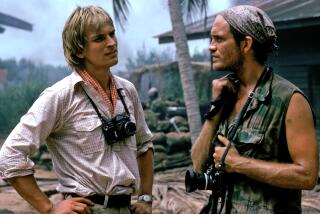Joan Root, 69; African Wildlife Filmmaker, Conservationist
- Share via
Joan Root, who with her ex-husband, Alan, made wildlife documentaries that transformed a termite colony, the nesting of a hornbill and swimming hippos into captivating entertainment, was killed Jan. 13 at her home in Kenya. She was 69.
Root was fatally shot by assailants who broke into her lakefront farmhouse outside Nairobi. Authorities suspect the conservationist was attacked because she tried to prevent illegal fishing on the lake. A former employee and a poacher are being held in the killing, police said.
The Roots, who made 10 movies together, were considered pioneers for making nature films that woke up the genre of wildlife documentaries. A 1981 Times review called them “one of the world’s greatest photographic teams.”
Their “Mysterious Castles of Clay” (1978), narrated by Orson Welles, received an Academy Award nomination. They spent months filming African termites building a towering mound that was destroyed within hours by an aardvark.
During their 20 years together, the couple brought a knack for high drama -- and a proclivity for hair-raising experiences -- to their projects.
While filming “Mzima: Portrait of a Spring” (1983), Joan was almost gored when an angry male hippo’s tusk punctured her diving mask. The same beast almost cost Alan his leg. But the footage of the hippos swimming underwater like prehistoric ballet dancers was “mesmerizing,” the Times of London said in 1989.
In “Lights! Action! Africa!” (1980), which documented the photographers’ work, Joan is shown being used as bait to lure a cobra to the camera. She stares down the captured snake as it repeatedly coats her glasses with deadly venom.
To catch the drama of wildebeest herds charging past, the Roots attached cameras to the shells of tortoises. The resulting “Year of the Wildebeest” (1975), narrated by James Mason, documented the mass migration of the hoofed mammals through Tanzania. With characteristic humor, Alan called the film “Brave Gnu World.”
Joan Wells Thorpe was born in Nairobi in 1936, the daughter of a British settler who was a coffee grower. From an early age, she had a passion for the African wilderness. She once swam with a python.
While working as a safari guide in 1961, she met Alan Root, a self-taught naturalist from London whose family had moved to Kenya when he was 9.
His interest in Joan was piqued when he learned she had hand-raised an orphaned elephant calf, considered a nearly impossible task when the animal is less than 6 months old.
The first night of their honeymoon was indicative of their life to come. Joan was stung by a scorpion as they camped by a bridge in eastern Kenya. As Alan comforted her, they sat up till dawn, listening to the roar of passing trains and a lion.
The couple, who had no children, divorced in 1981 but remained friendly. Alan remarried while Joan stayed at their 88-acre property, a wildlife sanctuary where she kept orphaned animals and campaigned to conserve the area’s wildlife and fish.
One of the couple’s greatest adventures was documented in “Balloon Safari Over Kilimanjaro” (1976) in which they became the first to balloon over the 19,340-foot-high peak. After unintentionally landing in Tanzania, they were arrested as “astronaut spies.”
“It was generally agreed because of the load factor only one passenger could make the ascent. Joan had not said a word but it was clear she would gladly have amputated an arm to meet the required weight,” John Heminway wrote in his 1983 book, “No Man’s Land: The Last of White Africa.”
Seconds before the balloon lifted off, Alan asked, “You ready?” and pulled her aboard.
More to Read
Only good movies
Get the Indie Focus newsletter, Mark Olsen's weekly guide to the world of cinema.
You may occasionally receive promotional content from the Los Angeles Times.








